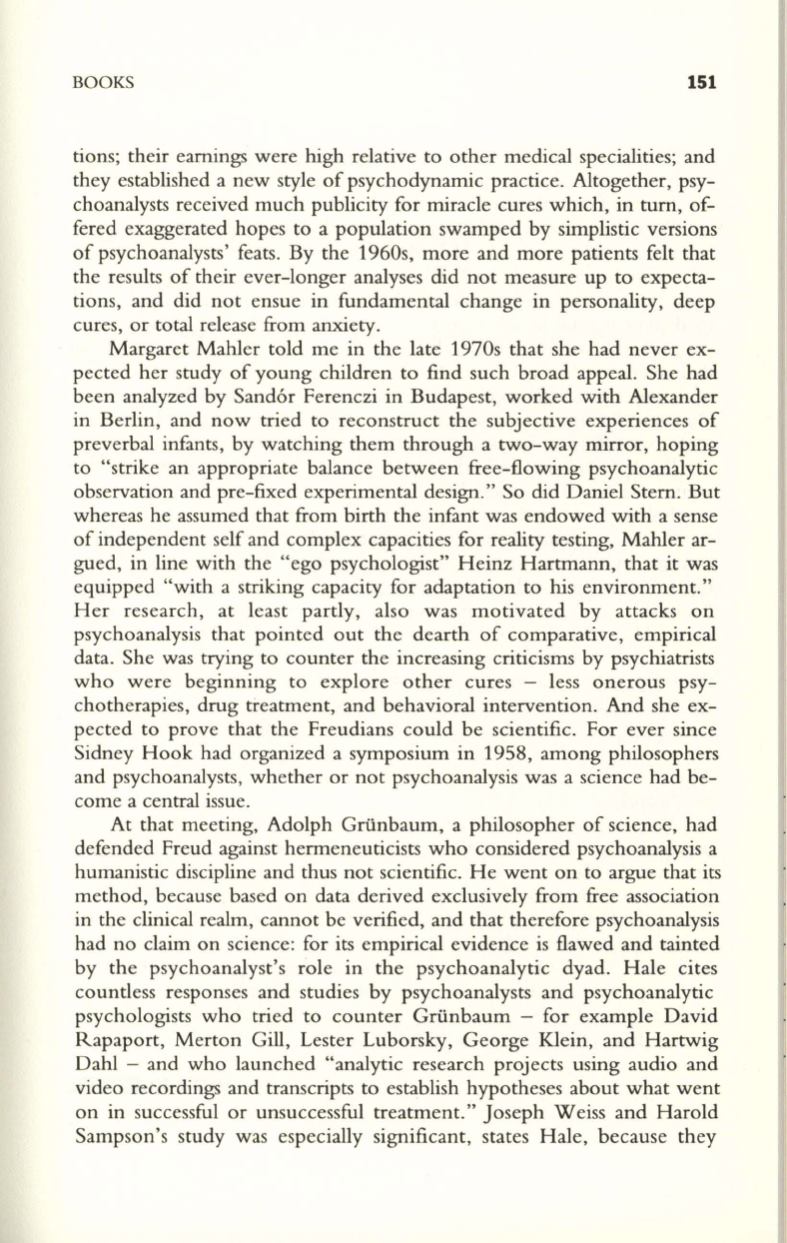
BOOKS
151
tions; their earnings were high relative to other medical specialities; and
they established a new style of psychodynamic practice. Altogether, psy–
choanalysts received much publicity for miracle cures which, in turn, of–
fered exaggerated hopes to a population swamped by simplistic versions
of psychoanalysts' feats. By the 1960s, more and more patients felt that
the results of their ever-longer analyses did not measure up to expecta–
tions, and did not ensue in fundamental change in personality, deep
cures, or total release from anxiety.
Margaret Mahler told me in the late 1970s that she had never ex–
pected her study of young children to find such broad appeal. She had
been analyzed by Sandor Ferenczi in Budapest, worked with Alexander
in Berlin, and now tried to reconstruct the subjective experiences of
preverbal infants, by watching them through a two-way mirror, hoping
to "strike an appropriate balance between free-flowing psychoanalytic
observation and pre-fixed experimental design." So did Daniel Stern. But
whereas he assumed that from birth the infant was endowed with a sense
of independent self and complex capacities for reality testing, Mahler ar–
gued, in line with the "ego psychologist" Heinz Hartmann, that it was
equipped "with a striking capacity for adaptation to his environment."
Her research, at least partly, also was motivated by attacks on
psychoanalysis that pointed out the dearth of comparative, empirical
data. She was trying to counter the increasing criticisms by psychiatrists
who were beginning to explore other cures - less onerous psy–
chotherapies, drug treatment, and behavioral intervention. And she ex–
pected to prove that the Freudians could be scientific. For ever since
Sidney Hook had organized a symposium in 1958, among philosophers
and psychoanalysts, whether or not psychoanalysis was a science had be–
come a central issue.
At that meeting, Adolph Griinbaum, a philosopher of science, had
defended Freud against hermeneuticists who considered psychoanalysis a
humanistic discipline and thus not scientific. He went on to argue that its
method, because based on data derived exclusively from free association
in the clinical realm, cannot be verified, and that therefore psychoanalysis
had no claim on science: for its empirical evidence is flawed and tainted
by the psychoanalyst's role in the psychoanalytic dyad. Hale cites
countless responses and studies by psychoanalysts and psychoanalytic
psychologists who tried to counter Griinbaum - for example David
Rapaport, Merton Gill, Lester Luborsky, George Klein, and Hartwig
Dahl - and who launched "analytic research projects using audio and
video recordings and transcripts to establish hypotheses about what went
on in successful or unsuccessful treatment." Joseph Weiss and Harold
Sampson's study was especially significant, states Hale, because they


